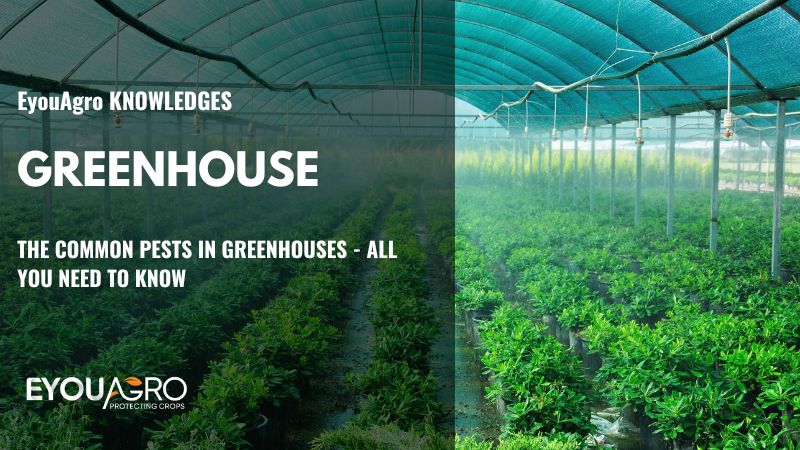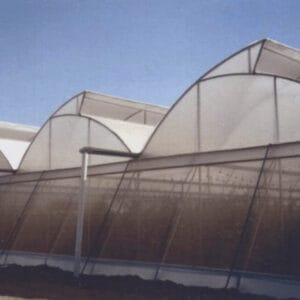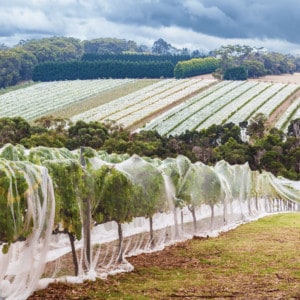The gardeners take exceptional pride in their work. But there are also many benefits in what they do. It helps them reduce the risk of stroke, burn calories, and improve their immune system. Besides, gardening minimizes the risk of dementia. And it works as free anger therapy and stress relief. If all this isn’t enough, it is an excellent economic business. But something can ruin all gardeners’ hard work.
What is that? Insects! Like all plant species, those grown indoors in the greenhouse have their pests.
Luckily, there is a way to protect your plants.
What are the common pests in the greenhouse?
Pests are a destructive insect, or other animals, that attacks crops and livestock. To say with other words, a pest is any organism that spreads disease and causes destruction. Also, not all insects are pests. Some kinds of insects eat other ones. So, those and are beneficial species.
Speaking about the pests, what are the most common ones? We would single out the tobacco whitefly, a leaf miner, aphids, and thrips.
The tobacco whitefly
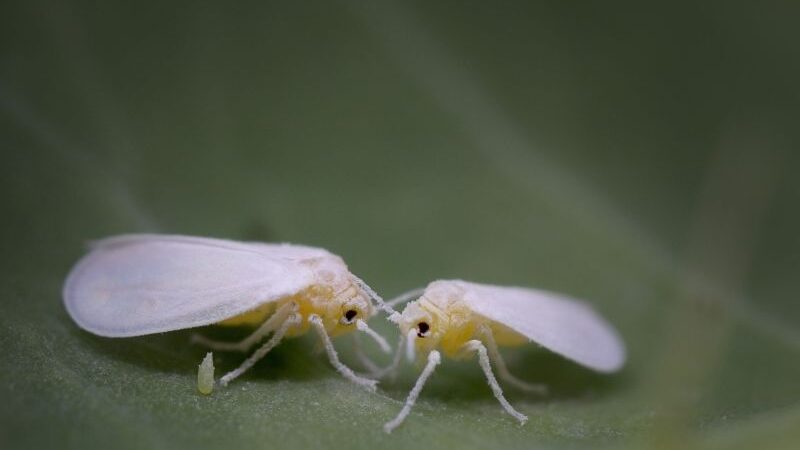
The tobacco whitefly (Bemisia tabaci) belongs to the family Aleyrodidae. It has an enormous host range and has affected an extensive range of crops worldwide.
The tobacco whitefly causes damage in (sub-)tropical areas especially. Yet, the biggest problem is a high level of resistance to many insecticides. And they even have the propensity to send viruses.
How to identify them? Check the leaves’ undersides—especially around the veins—for white insects. Even if they aren’t immediately visible, leaf surfaces will be sticky. While you are touching the plant, the whiteflies will fly off. So, it is undeniable they are feeding there.
Are they harmful? They are harmless to people. Yet, they can do a lot of damage to the plants we grow.
The damage tobacco whitefly do is:
1. Larvae and adults are sucking plant sap
2. Increasing secretion of honeydew
3. Slowing down the photosynthesis of the plant
4. Spreading several destructive plant viruses such as Tomato yellow leaf curl virus
5. Causing several physiological disorders
What happens if the population of tobacco whiteflies is enormous? Their feeding on plant sap can affect the plant’s physiology. Due to it, growth will be slow. In full sunlight, leaves can weaken and fall. Such leaf loss is possible, in turn, to influence the development of fruit and lead to a decrease in yield.
The honeydew deposited on fruit makes it sticky. That results in products being unsuitable for sale. And in more severe cases, the fruit will rot. Dirty molds also occur on the leaves, decreasing photosynthesis and transpiration.
The larvae inject enzymes into the plant. That changes their normal physiological process.
Additionally, this can cause damage such as
1. irregular ripening in tomatoes and sweet peppers,
2. yellowing of the flower stalks in gerbera, and
3. severe yellowing of French beans’ leaves.
How to get rid of tobacco whitefly? Spray with the pesticides on the underside of the contagious leaves. The best is to do it in the mornings or evenings when it is cooler.
Bear in mind that single female whitefly can lay over 400 eggs. So sometimes, the reaction comes too late, and the plant is already damaged.
A leaf miner

Leaf miners are the insect family. They feed between on leaves.
These insects won’t bite or harm humans. They won’t even kill the plant, but the damage isn’t insignificant. It will affect how the plant looks by creating tunnels on the leaves. Yellow lines or spots are also visible on the infected leaves. Sometimes, the infection can worsen and cause leaves to be brown and then fall before the end of the season. So, taking action to get rid of them is a must.
How to identify them? Leaf miners are like black flies. Yet, the flies do not directly cause damage to the plant. Instead, the larva does.
The most common treatment against leaf miners is spraying pesticides. The biggest problem is taking action at the right time. Spraying too early or too late won’t kill the pest. What is the recommendation? In the early spring, put a few infected leaves in a plastic bag. Wait to see black flies. That will mean that larva became an adult. Just then, spray the plants daily for a week. Be aware that this is the best way, yet it is not always working either.
Another way is to try with beneficial bugs (and to hope they will do the job).
The third way is also natural: using neem oil. The benefit is reducing the number of larvae that become adults. And fewer adults means fewer eggs in the future.
Aphids
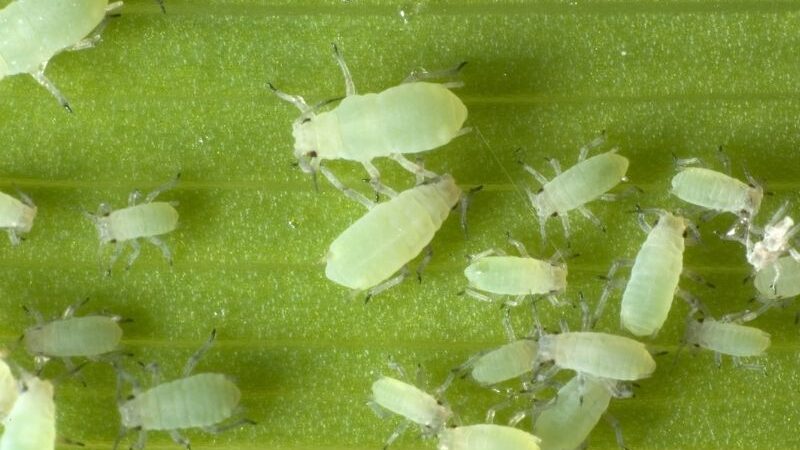
Aphids are small, soft-bodied insects. Hence their size they are often invisible to the naked eyes. The color of aphids varies from white to yellow, green, or even pink.
They feed by sucking the rich parts of plants by attacking leaves, flowers, and even roots. But how to recognize the infected plant? Look for misshapen or yellowing leaves. Also, flowers and fruit may be deformed.
Unlike some pests that are harmless to people, aphids aren’t. They can trigger allergic reactions. What about plants? They can send viruses between plants and also attract other insects. What you need to worry the most about- they reproduce quickly.
Tips to get rid of aphids:
1. Try sprinkling cold water on the leaves. Usually, they can’t find their way back to the same plant,
2. Spray leaves with water and a few drops of dish soap. Re-do it every 2-3 days for two weeks,
3. Dust plants with flour,
4. Apply neem oil,
5. Try applying diatomaceous earth (DE), a non-toxic, organic material that will kill aphids. Don’t do it when plants are in bloom; it is toxic to pollinators, too.
Thrips

Thrips are tiny insects, straw-colored or black, with two pairs of wings. They do not need to mate for reproduction, yet they feed in large groups. Each female can give up to 80 eggs.
Thrips aren’t toxic to humans, but they can harm us. People who have allergies to bug bites might get irritation. When it comes to plants, they are dangerous. The infected plant will look pale and twisted and then will die.
Tips to get a win against these pests:
1. Remove weed from around the greenhouse. Dry mulch will not draw thrips,
2. Throw any plants with signs of thrips,
3. Spray plants with water to reduce pest numbers,
4. Use any available beneficial insects,
5. Try with neem oil,
6. If nothing else helps, apply chemical pesticides.
Preventive measures: The anti-insect netting
As we could already conclude, although there are ways to fight pests, nothing is for sure a success. Seeing that, we may say that we can’t be sure that we’ll cure the plant. Further, it will make all our hard work wasted.
Thus, the recommendation is prevention. Prevention includes those preventive measures before the insect even attacks the plant. It is not possible to make plants unattractive to insects. But it is possible to protect their penetration to plants, at least when it comes to greenhouses.
How to protect the entrance to the greenhouse? By setting the anti-insect netting.
Anti- insect netting is a thin fabric. Thanks to that, it will allow sunlight to enter, and it won’t block the rain. The only ones that will stop are the insects.
12 reasons to install the anti-insect net:
1. It is a small investment, less pricey than losing plants due to insects
2. It doesn’t have a thermal effect
3. It is durable in harsh weather, which means you won’t need to keep buying a new net
4. It is anti-corrosion
5. There are different mesh sizes & dimensions, depending on the plants’ need
6. It is easy to set it up, no much effort
7. Anti-insect net is non-toxic, environmentally friendly
8. The use of insecticides will be reduced
9. Green pollution-free food will increase
10. The temperature will be rising
11. The most significant light will still be reaching the plant
12. You’re saving yourself from the risk of allergies.
Why choose EyouAgro net?
EyouAgro manufactures everything in the family-run factory and supplies directly to the farmers. Not the middleman who is taking the pre-cent means saving the money. And twenty-five years of experience are guaranteeing quality. It is enough to say that material is 100% virgin high-density polypropylene. But it is good to know that warranty is five years.
Conclusion
Many pests aren’t harmful directly to humans. But we can’t say they don’t harm us. The effect they have on people is stress. Stress can cause physical, emotional, or psychological tension. Actually, that is your body’s response to what is happening around you. And, as you know, it can lead to several diseases. Watching insects feed on your plants is difficult. And especially when the treatment does not bring results.
Plus, there is an economic loss. Insects can cause the entire season to be destroyed. So, it would help if you do all to prevent them from entering your construction.
Luckily, the solution is far more than simple- the anti-insect net

